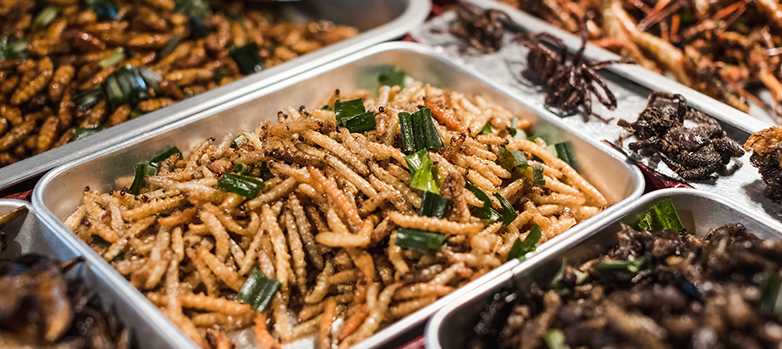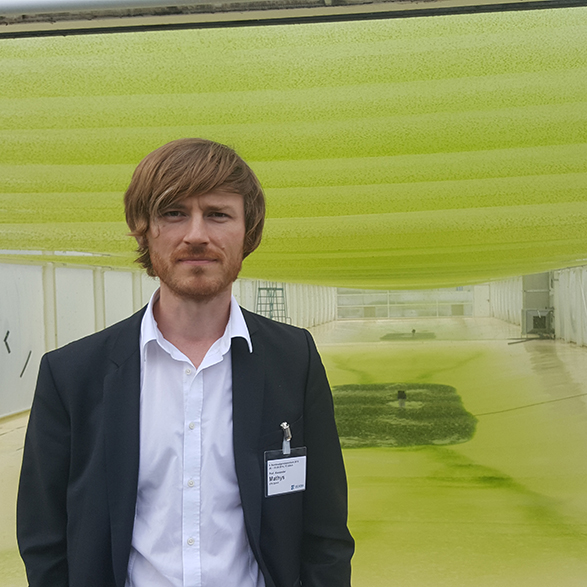Insects and algae in place of beef and chicken
Conventional livestock farming alone cannot meet the world population’s growing demand for protein. Alexander Mathys, Professor of Sustainable Food Processing, is seeking out the most sustainable alternatives.

Alexander Mathys seems to be a much sought-after man: in his first few months as Professor of Sustainable Food Processing at ETH Zurich he has already made several appearances in the Swiss media. And Schweizer Radio has just asked him for an interview. His popularity is due not only to his eloquence and enthusiasm for the subject, but because his specialist area is currently a hot topic in the media: insects as a food item. This is more than just the latest food trend. Insects are a food source with the potential to meet the protein needs of a growing global population in a sustainable way. Compared to raising traditional livestock, farming insects supplies more protein for less space and fewer resources; some species have a protein content of up to 80 percent.
But whereas insects are widely consumed throughout Asia and South America, the food industry in Switzerland is treading new ground: in this country, insects are a novel food and not yet approved for human consumption. But this may soon change, with Switzerland due to permit the consumption of certain insect species as early as next year. In Europe, too, insects could soon start appearing on more menus.
A closer look
“There’s a great feeling of excitement,” says Mathys. But he is not quite as euphoric as some advocates. True, insects have some significant advantages over pigs, chicken and particularly cows. But unreservedly promoting insects as the single most sustainable solution would be misleading, he thinks. How will these insects be fed? How will they be kept? How will they be processed after they have been reared? “There are many aspects we need to look into closely,” says our researcher, “and we shouldn’t forget algae and pulses, which could also go a long way to meeting the growing demand for protein. In terms of sustainability, these plant sources are often better than insects.”
Mathys backs up his argument by reference to a recently published article he has written with colleagues – an analysis comparing the life cycles of various protein sources. “This study gives a good overview of the most important factors,” he explains, “and it’s an ideal starting point, as we now know which processes we need to improve first.” Over the next few years, the researcher wants to work with Bühler – the company providing start-up financing for his chair, together with the Migros Group’s M-Industry companies – and other partners to optimise insect processing. “Bühler has considerable expertise and experience in the food technology field,” says Mathys. “Our aim now is to optimise the exist ing processes so that we can filter off and conserve the valuable content of the insects as carefully as possible.”
As much biomass as possible

Mathys considers algae just as important as insects: “I see a lot of potential here,” he says with conviction. “First, certain algae have a very high protein content. Second, as the cultivation method is currently at a low technical level, there is plenty of scope for us to optimise it.” The main task is to cultivate as much biomass as possible in a given quantity of water. How can we set up the cultivation plant so that the algae can absorb maximum light and CO2? And how can we then draw off the algae as efficiently and carefully as possible in order to process their valuable protein content?
“Another reason algae and insects are attractive alternatives is that they can be cultivated on unproductive terrain – meaning even wasteland can be used to produce food,” explains Mathys. This would marry well with the “urban farming” concept of producing food in cities themselves. “The number of people living in megacities is growing all the time; providing them with good-quality food is a major challenge,” says Mathys, defining the problem. But urban farming alone cannot solve this: “We can’t eat raw produce alone; it needs to be processed into safe, non-perishable foodstuffs. That’s why we have to talk about urban food processing, too, and how we can process food in small on-site systems.”
Plenty of new ideas
One interesting approach here is micro-processing technology, which allows for a continuous production process even with small quantities of raw materials. Already in use for producing high-grade chemicals in smallscale plants, this method could perhaps be applied in food processing, too. “Many good ideas fall by the wayside because approaches that work very well with laboratory-scale batches don’t produce the desired results in continuous industrial operation,” explains Mathys. “With microprocessing technology, we can identify possible problems at the lab stage and optimise the process accordingly.” Nestlé has now offered him suitable research equipment for testing his new ideas for preserving and processing sensitive, high value-added ingredients.
But Mathys has plans that go even beyond that: “There is great potential to use insects not only for food but also as animal feed,” he claims. “We’re looking to breed larvae on faecal waste in non-central locations, and use them to feed livestock.” This would be an attractive option for developing countries, where farmers generally have no access to protein-rich feed for their animals.
Mathys has already gotten his first taste of success: he’s just received project financing from the Sawiris Foundation, as part of the Engineering for Development (E4D) scholarship programme. This funding will allow him to continue developing the application in collaboration with Stellenbosch University in South Africa, the Chinese Huazhong Agricultural University, and EAWAG in Dübendorf. But there are still many issues to be clarified, not least that of food and feed safety.